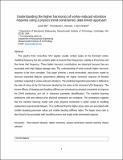Understanding the higher harmonics of vortex-induced vibration response using a trend-constrained, machine learning approach
Author(s)
Ma, Leixin; Resvanis, Themistocles L.; Vandiver, J. Kim
DownloadAccepted version (10.82Mb)
Publisher Policy
Publisher Policy
Article is made available in accordance with the publisher's policy and may be subject to US copyright law. Please refer to the publisher's site for terms of use.
Terms of use
Metadata
Show full item recordAbstract
The spectra from cross-flow VIV signals contain peaks at the dominant vortex shedding frequency but also at several other frequencies, notably at three times and five times that frequency. These higher harmonic contributions are important because they are associated with high fatigue damage rates. The understanding of what controls higher harmonic response is far from complete. This paper presents a trend-constrained, data-driven model to discover important features (parameters) affecting the higher harmonic response of flexible cylinders subjected to vortex-induced vibrations. The predicted dependent parameter is the ratio of stress at the 3rd harmonic divided by the stress at the dominant VIV frequency. The known effects of damping and bending stiffness are introduced as physical constraints to improve the DNN predictions and aid in important parameter identification. The machine learning predictions with and without prior physical constraints are compared. The comparison suggests that the machine learning model with prior physical constraints better handles independent experimental datasets. It is confirmed that the higher stress ratios are associated with smaller damping parameter values and smaller bending stiffness ratios. The larger stress ratio is also found to be associated with traveling waves and single-mode-dominated responses.
Date issued
2022-05Department
Massachusetts Institute of Technology. Department of Mechanical EngineeringJournal
Marine Structures
Publisher
Elsevier BV
Citation
Ma, Leixin, Resvanis, Themistocles L. and Vandiver, J. Kim. 2022. "Understanding the higher harmonics of vortex-induced vibration response using a trend-constrained, machine learning approach." Marine Structures, 83.
Version: Author's final manuscript
ISSN
0951-8339